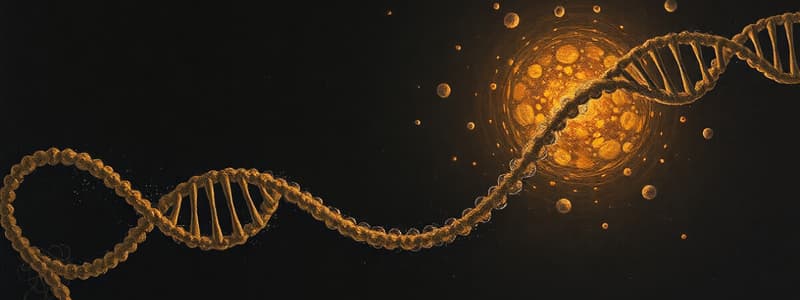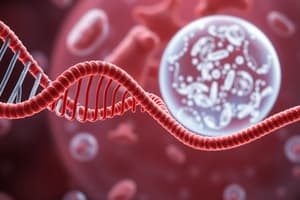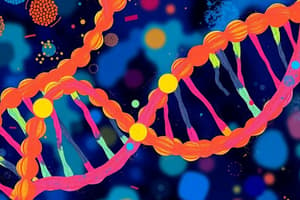Podcast
Questions and Answers
A cell has irreparable DNA damage during the G1 phase. Which cell cycle checkpoint is most likely to trigger cell cycle arrest?
A cell has irreparable DNA damage during the G1 phase. Which cell cycle checkpoint is most likely to trigger cell cycle arrest?
- Spindle assembly checkpoint
- M checkpoint
- G1/S checkpoint (correct)
- G2/M checkpoint
During mitosis, chromosomes are aligned at the metaphase plate by dynamic instability of microtubules. Which of the following would disrupt this process?
During mitosis, chromosomes are aligned at the metaphase plate by dynamic instability of microtubules. Which of the following would disrupt this process?
- Centrosome duplication
- An increase in tubulin subunit concentration
- Loss of sister chromatid cohesion
- A drug that stabilizes microtubule polymers (correct)
A researcher observes that a cell line has a high rate of thymine dimer formation due to UV exposure. Which DNA repair mechanism is most likely deficient in this cell line?
A researcher observes that a cell line has a high rate of thymine dimer formation due to UV exposure. Which DNA repair mechanism is most likely deficient in this cell line?
- Base excision repair
- Homologous recombination
- Mismatch repair
- Nucleotide excision repair (correct)
A mutation in the promoter region of a gene reduces its transcription rate. Which of the following is the most likely mechanism for this effect?
A mutation in the promoter region of a gene reduces its transcription rate. Which of the following is the most likely mechanism for this effect?
A cell receives a signal that activates a receptor tyrosine kinase (RTK). Which of the following is an immediate downstream effect of RTK activation?
A cell receives a signal that activates a receptor tyrosine kinase (RTK). Which of the following is an immediate downstream effect of RTK activation?
If a cell lacked the ability to properly regulate the G2/M checkpoint, what would be the most likely outcome?
If a cell lacked the ability to properly regulate the G2/M checkpoint, what would be the most likely outcome?
What would be the most likely result if the enzyme telomerase were non-functional in a cell?
What would be the most likely result if the enzyme telomerase were non-functional in a cell?
A cell has a mutation that disables its mismatch repair system. What is the most likely consequence of this mutation?
A cell has a mutation that disables its mismatch repair system. What is the most likely consequence of this mutation?
A signaling pathway involves a series of protein kinases that phosphorylate each other, ultimately activating a transcription factor. What is the primary purpose of this phosphorylation cascade?
A signaling pathway involves a series of protein kinases that phosphorylate each other, ultimately activating a transcription factor. What is the primary purpose of this phosphorylation cascade?
How does the process of DNA replication relate to the cell cycle?
How does the process of DNA replication relate to the cell cycle?
What is the primary role of the spindle assembly checkpoint during mitosis?
What is the primary role of the spindle assembly checkpoint during mitosis?
Which of the following best describes the outcome of mitosis?
Which of the following best describes the outcome of mitosis?
What distinguishes nucleotide excision repair from base excision repair?
What distinguishes nucleotide excision repair from base excision repair?
How does a ligand binding to a receptor initiate a cell signaling pathway?
How does a ligand binding to a receptor initiate a cell signaling pathway?
What is the significance of having checkpoints during the cell cycle?
What is the significance of having checkpoints during the cell cycle?
A cell with a mutation in a gene encoding a protein involved in homologous recombination is likely to exhibit:
A cell with a mutation in a gene encoding a protein involved in homologous recombination is likely to exhibit:
What role do transcription factors play in gene expression?
What role do transcription factors play in gene expression?
A mutation that causes a cell to bypass the restriction point in the G1 phase would likely result in:
A mutation that causes a cell to bypass the restriction point in the G1 phase would likely result in:
During which phase of mitosis do sister chromatids separate and move towards opposite poles of the cell?
During which phase of mitosis do sister chromatids separate and move towards opposite poles of the cell?
Flashcards
Transcription
Transcription
Creating RNA from a DNA template.
Cell Communication
Cell Communication
Cells signaling each other to coordinate actions.
Cell Cycle
Cell Cycle
Series of events leading to cell division and duplication.
Mitosis
Mitosis
Cell division resulting in two identical daughter cells.
Signup and view all the flashcards
DNA Replication
DNA Replication
Producing two identical DNA replicas from one original DNA molecule.
Signup and view all the flashcards
Telomerase
Telomerase
Enzyme adding DNA sequence repeats to telomere ends.
Signup and view all the flashcards
DNA Damage & Repair
DNA Damage & Repair
Mechanisms cells use to correct DNA damage.
Signup and view all the flashcards
Translation
Translation
mRNA directs protein formation at the ribosome.
Signup and view all the flashcards
Cell Cycle Phases
Cell Cycle Phases
G1, S, G2, and M phase (mitosis).
Signup and view all the flashcards
Mitosis Stages
Mitosis Stages
Prophase, metaphase, anaphase, and telophase.
Signup and view all the flashcards
DNA Repair Mechanisms
DNA Repair Mechanisms
Nucleotide excision repair, base excision repair, and mismatch repair.
Signup and view all the flashcards
Gene Expression
Gene Expression
Information from a gene is used in the synthesis of a functional gene product.
Signup and view all the flashcards
Cell Signaling Pathways
Cell Signaling Pathways
Receptors, ligands, and downstream effectors transmit signals.
Signup and view all the flashcardsStudy Notes
- Transcription is the process of creating RNA from a DNA template
- Cell communication involves cells signaling to each other to coordinate actions
- The cell cycle is a series of events that take place in a cell leading to its division and duplication
- Mitosis is a type of cell division that results in two daughter cells each having the same number and kind of chromosomes as the parent nucleus, typical of ordinary tissue growth
- DNA replication is the process of producing two identical replicas from one original DNA molecule
- Telomerase is an enzyme that adds DNA sequence repeats to the 3' end of DNA strands in the telomere regions
- DNA damage & repair refers to the mechanisms that cells use to identify and correct damage to their DNA
- Translation is the process where genetic information coded in messenger RNA directs the formation of a specific protein at a ribosome in the cytoplasm
Phases Of Cell Cycle
- The cell cycle includes phases such as G1, S, G2, and M phase (mitosis)
Mechanisms Of Mitosis
- Mitosis involves stages like prophase, metaphase, anaphase, and telophase
DNA Repair Mechanisms
- DNA repair mechanisms include nucleotide excision repair, base excision repair, and mismatch repair
Gene Expression
- Gene expression is the process by which information from a gene is used in the synthesis of a functional gene product
Cell Signaling Pathways
- Cell signaling pathways involve receptors, ligands, and downstream effectors to transmit signals
Studying That Suits You
Use AI to generate personalized quizzes and flashcards to suit your learning preferences.




